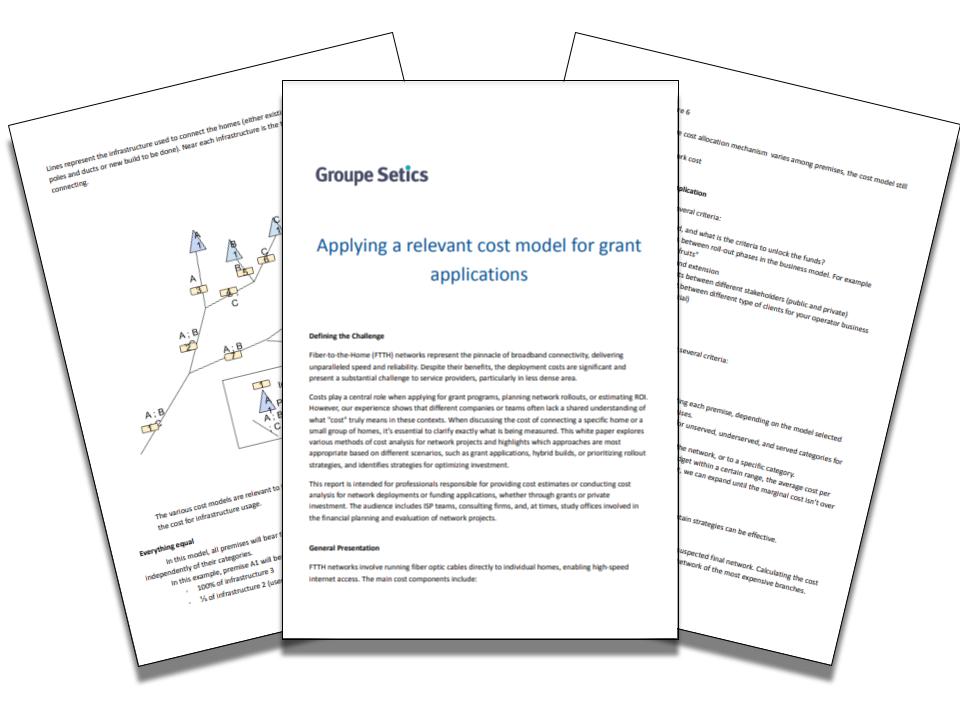When it comes to fibre network deployment, cost is unarguably a key consideration in the decision-making process. However, the term "cost" can mean different things to different stakeholders.
From operators and engineers to funding bodies and public authorities, the term “cost” is not one-dimensional. Understanding and navigating these different interpretations is important in ensuring that fibre network projects, particularly those targeting underserved or rural areas, are both financially viable and technically efficient.
Why is it important to define cost in network deployment?
Fibre network deployment can involve significant financial investment, so cost is always a key consideration. However, according to Michel Ayoun, Product Manager at Setics, when different stakeholders talk about cost, they are not always referring to the same thing. “It’s a bit like accounting – a single term can cover a range of meanings,” he explains. For example, an engineer, a network builder, or a funding provider may all discuss costs, but each will likely approach the subject with a different set of priorities.
A major focus for operators is ensuring that all costs are clearly defined and communicated, particularly when applying for grants, subsidies, or private equity to fund their networks. Ayoun explains: “When there’s a mix of private and public funding, the focus on cost increases, and how that cost is calculated and justified becomes even more important.”
Challenges in fibre network deployment
One of the greatest challenges operators face when deploying fibre networks, particularly in unserved or underserved regions, is the complexity of the project footprint. These regions, often rural or hard-to-reach areas, can present their own technical challenges. Operators need to make important decisions about which areas to connect and how to do this in the most cost-effective way. “Making smart decisions regarding the network footprint is a huge challenge because it’s technically difficult and often must be done within a very short timeframe,” says Ayoun.
When applying for public funding or competing for subsidy programmes, operators often have a limited period of time to provide very technical answers. Decisions must be made quickly and accurately, involving collaboration between teams with varying expertise. The challenge, says Ayoun, is: “How can you decide quickly and make smart decisions that are close enough to accurate, while also being transparent and justifiable to stakeholders?”
Cost models and accounting for fibre networks
When it comes to choosing the right cost model for a fibre deployment project, Ayoun likens the process to accounting practices. While the total cost of building a network remains constant, how that cost is presented and analysed can vary. For example, if an operator purchases equipment to produce two objects, the cost can either be divided equally between both objects or allocated differently depending on the approach taken. “In accounting, you have methods of presenting numbers in certain ways, but the total cost doesn’t change. It’s the same for networks – a network will cost what it costs, but you can analyse that cost differently depending on the business model,” he explains.
The right cost model is heavily dependent on the type of project being undertaken. For purely commercial networks, where private funding is the sole source of investment, one cost model may suffice. However, if public and private money are combined, a more nuanced model is required. This is where operators need to ensure that their accounting reflects the unique funding mix of the project. Failure to do so could result in missed opportunities for additional subsidies or even the rejection of the project altogether.
How to balance cost efficiency with coverage
In more rural areas, the challenge for operators is to balance the cost efficiency with the need for comprehensive coverage. "In many cases, operators have to work within a pre-defined footprint, which can make it harder to plan cost-efficient networks," says Ayoun. One strategy for this is to rely on more conservative estimates of deployment costs, focusing on identifying the expensive parts of the network early.
Alternative technologies such as fixed wireless access (FWA) or satellite communications can provide connectivity to remote areas without the need for full fibre deployment, as Ayoun says: “It’s about identifying the most expensive parts of the network and considering alternatives. There’s no secret – it’s mostly based on common sense. But the technical challenges are often significant, and having the right tools and expertise to make these decisions is crucial.”
Full-fibre is widely considered to be the preferred solution, but operators may consider these alternative technologies, especially in rural regions. Fixed wireless access is not as technically robust as fibre-to-the-home (FTTH), but it can offer viable connectivity at a lower cost. Says Ayoun: “This trade-off between cost and service quality is something operators have to consider carefully.”
Looking to the future: frameworks and funding
Looking ahead, the regulatory frameworks and funding programmes that govern fibre network deployment will continue to play a role in shaping how operators approach these projects. In regions such as the US, for example, state-level broadband programmes are being carefully crafted to balance the interests of public authorities and private operators. These negotiations, Ayoun believes, will have a major impact on the success of future deployments.
“States are treading lightly, trying to maximise the return on public investment while ensuring operators don’t just take on the profitable parts of a project,” he explains. The balance between public interest and private profitability will remain a key focus in the deployment of fibre networks, particularly in rural areas where costs are high and returns are lower.
The role of technical expertise and external support
For many operators, particularly smaller or newer companies, securing the right technical expertise can be a challenge. Whether it’s in-house teams or external partners, having access to skilled professionals who understand the technical and financial intricacies of fibre deployment is vital. “Some operators are smaller companies, startups even, who might have great ideas but struggle to get the right technical teams in place at the right time,” Ayoun notes.
To consider all of the factors and impacts on their projects, operators often turn to external partners to fill the gaps. Says Ayoun: “Sometimes it’s easier to rely on external support, especially when you need the right tools, methodologies, and experience to navigate complex decisions.”
Setics Group offers support to operators that extends beyond network deployment alone. With tailored solutions for each stage of the project lifecycle, the company helps to empower FTTH stakeholders, including operators, local authorities, and financial institutions, to effectively address challenges. From strategic consulting and automated network design to cost-assessment, quality assurance and deployment monitoring, Setics can provide end-to-end assistance to ensure the success of FTTH projects.
Find out more detailed information in the latest White Paper from Setics, which outlines the critical factors and strategies to consider in managing FTTH network costs, ensuring a balanced approach that maximises value for both providers and consumers.



